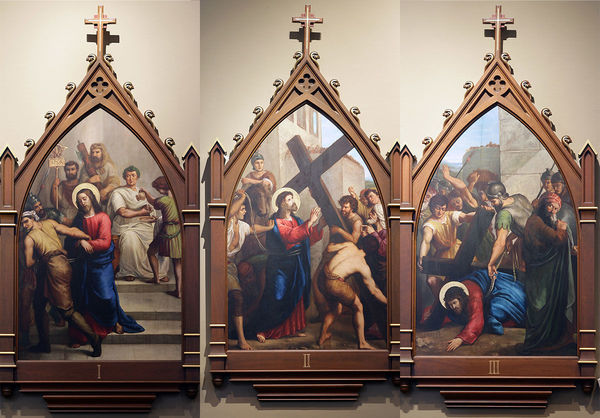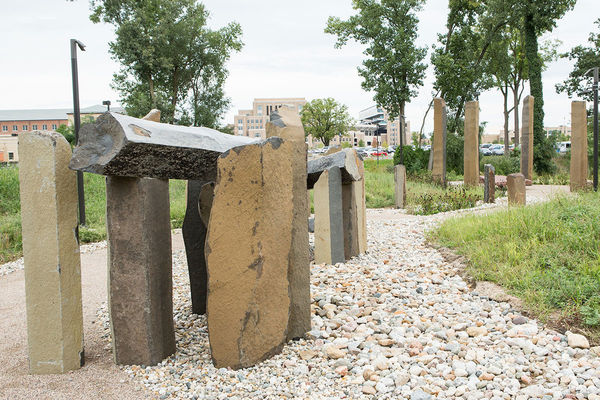

Anyone interested in Michaelangelo’s paintings on the ceiling of the Sistine Chapel could pull them up on a computer screen in a matter of seconds. They could take time and view details impossible for most Vatican visitors to see from afar and in the limited time they have in the chapel.
Still, a digital image of The Creation of Adam doesn’t tend to stir the soul in the same way as looking up at it while standing in the same room where popes have been elected and some of the world’s most famous artists have left their marks. The context matters.
Notre Dame theology and psychology faculty will extrapolate on that idea thanks to a $230,000 grant from the Templeton Religion Trust for an 18-month project titled “Understanding the Enduring Impact of Encounters with Sacred Art on Individual Spiritual Reality.”
Robin Jensen, the Patrick O'Brien Professor of Theology; James Brockmole, the Joseph and Elizabeth Robbie College Professor of Psychology and the College of Arts and Letters' associate dean for research and strategic initiatives; and G.A. Radvansky, professor of psychology, will explore the ways in which viewing art informs and enhances spiritual growth and how that changes based on time and place. Consultants on the project include Joseph Becherer, director of the Snite Museum of Art; Erika Doss, professor of American studies; and Maria Tomasula, the Michael P. Grace Professor of Art.
“Since Vatican II, we have had a variety of renovations and decorations for churches that have created different environments in which people worship,” Jensen said. “How does that change the content of their faith? They’re being strongly impacted by what’s around them, and we’re interested in how these spaces change the experiences in religious settings, but also how people are affected by religious art in more secular settings.”
“Since Vatican II, we have had a variety of renovations and decorations for churches that have created different environments in which people worship. How does that change the content of their faith? They’re being strongly impacted by what’s around them, and we’re interested in how these spaces change the experiences in religious settings, but also how people are affected by religious art in more secular settings.”
The researchers will focus on two sets of religious art on the Notre Dame campus — The Stations of the Cross by Luigi Gregori in the Basilica of the Sacred Heart, and The Life of Christ/Cycle of Life by Philip Rickey in the Charles B. Hayes Family Sculpture Park.

As part of the study, Brockmole said, viewers will take in the art in their current physical settings, but the research team will also show the same pieces digitally and change their context. They may show the piece as part of a museum display, for example, or presented against different backgrounds.
Eye-tracking technology can analyze how viewers are experiencing the art in those settings. Researchers can also question the viewers to see how they describe their experiences and how that changes based on the art’s location, the time since they’ve seen the piece, or the time of the year in which they see it.
“This is sacred art, and people have to make meaning out of it,” Brockmole said. “This allows us to look at how people extract meaning and engage with the world in different ways.”
Jensen said she expects that the timing of a piece of art’s viewing could have major significance for the viewer. The Stations of the Cross, for example, might be pieces that some churchgoers don’t pay much attention to every week. But during Lent, when the scenes are playing out in the Gospel readings, they may make a more deep spiritual connection.
The findings of this work could be applicable to both churches and museums, Jensen and Brockmole said, including on campus. Discoveries about how art informs religious or spiritual understanding could help churches shape their messages through paintings and sculpture. And the team plans to use their deeper understanding of how people view and remember sacred art to offer a more powerful experience for Snite Museum visitors by developing an engagement booklet for the studied artworks.
“It would be interesting to know how much people attend to the physical environment of their church and how that changes what they believe and how they encounter the liturgical year,” Jensen said. “If you’re curating an exhibition at a museum, you have a story to tell. We’re really interested in the ways in which this will impact how curators will think about their work.”
“This is sacred art, and people have to make meaning out of it. This allows us to look at how people extract meaning and engage with the world in different ways.”
Originally published by at al.nd.edu on October 13, 2020.